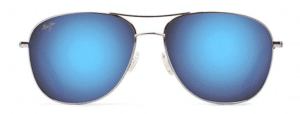Top 5 Reasons to Wear Sunglasses
What’s the one place on your body that you can’t apply sunscreen? Just like your skin, your eyes need protection from exposure to the sun’s harmful rays, every time you step outside.
You’re exposed to sunlight more than you think – Always choose sunglasses that block out 99%-100% of harmful UV rays to ensure your eyes are protected. Ask your eye care professional about non-prescription and prescription sunglasses to protect your eyes and eliminate glare while outdoors or driving.

1. Sunglasses Provide UV Protection
The sun’s harmful UV rays can lead to serious, and in some cases, long-term health issues, including: photokeratisis (sunburn of the eye’s surface), pterygium (growths on the eye), cataracts, and macular degeneration. Sunglasses that do not provide UV protection can cause more damage by shading the eye – causing the pupil to dilate and allowing in more harmful UV rays.
2. Reduce Your Risk of Skin Cancer
5%-10% of skin cancer occurs around the eyes. Sunglasses are not just for sunny days. Always wear quality, protective sunglasses when outdoors – whether working, driving running, gardening, playing, or watching sports.
3. Increase Your General Eye Comfort
The sun’s brightness and glare interfere with comfortable vision and the ability to see clearly – causing squinting, eyes to water, and possible headaches.
4. Improve Your Dark Adaptation
Spending even a relatively short time in intense sunlight can hamper the eyes’ ability to adapt to nighttime or indoor light levels, and can make driving at night difficult and even hazardous.
5. Blue-Light Protection is Enhanced
Use outdoor lenses that absorb the HEV (high-energy visible radiation), as accumulated exposure has been associated with AMD (age-related macular degeneration).

At Laser Eye Institute, we are proud to feature Maui Jim’s PolarizedPlus2 Sunglasses. Their proprietary prescription and non-prescription lens material combines the best of both worlds, optics nearly as clear as glass with just one-third the weight of your average pair of sunglasses. During your next visit, ask about our selection.
Share This Article
Posted by Amanda Zellar
Amanda helps patients improve their lives through the power of LASIK. A patient coordinator at Laser Eye Institute, Amanda assists patients through every step in their start-to-vision journey.

